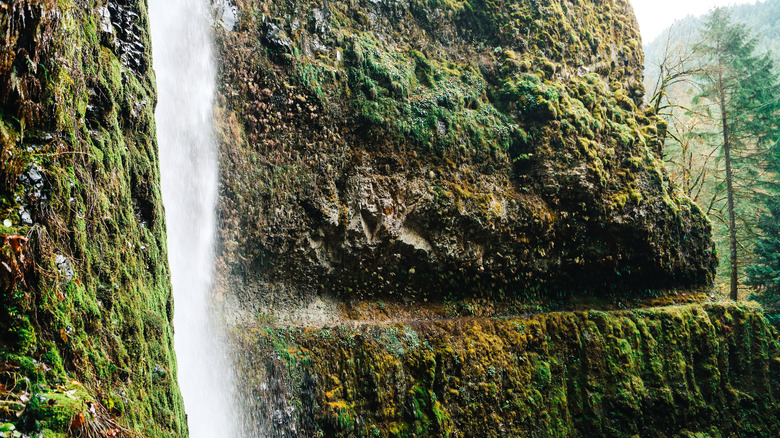Nestled Along The Columbia River Gorge Is A Popular Oregon Hiking Trail Full Of Waterfalls And Mountain Views
The Columbia River Gorge is a natural sanctuary full of verdant foliage, misty waterfalls, and unbeatable hiking trails which let you see views of this unique Oregon landscape up close. There are plenty of hikes to enjoy, from the easy but rewarding Wahclella Falls Trail to the grueling trek to the summit of towering Mount Defiance. The very best, however, might be Eagle Creek Trail. Along this incredible route, you can expect to see lush, foggy forests, rushing creeks, mossy cliff sides, a bridge over a 150-foot gorge, and waterfall after waterfall along the trail. The trail even takes hikers behind the falls to feel the spray of the cool water on their faces.
While you won't have to worry about figuring out how to keep in touch with your loved ones like you would on a thru-hike, this epic journey isn't something you can do in an afternoon and still be back in time for dinner. While it is possible to do the entire thing in one day, you should expect to be on the trail actively hiking for 12 to 14 hours. Many hikers prefer to split it up into two days, spending the night at one of the campsites along the route and continuing in the morning. A day pass to the Columbia River Gorge National Scenic Area only costs $5, which is what you can expect to pay from the Eagle Creek Trailhead. If you come from the Wahtum Lake Traillhead, which is in the Mark O. Hatfield Wilderness, it will cost $10.
What to expect along Eagle Creek Trail
Picture a sheer rock wall covered in lush green moss with a rocky path along the top. This route runs along one of the walls of the narrow canyon, carved out by the powerful flow of Eagle Creek. Be prepared for fog, rain, and mud. Not only is this the notoriously rainy Pacific Northwest, the spray from the creek keeps things fairly damp a lot of the time. This trail has a lot of waterfalls, from small, nameless dips in the creek to larger, more dramatic falls including destination waterfalls (the kind people travel to see). The water gushes down into a circular stone chasm, alive with vegetation, to fill a deep blue-green pool known as the Punch Bowl. At another point, Loowit Falls plunges down 90 feet.
Further along the trail, you'll encounter the staggering Tunnel Falls (pictured above). This incredible waterfall is not quite as well-known as Punch Bowl Falls, but it's significantly taller. The water plummets 170 feet down a sheer moss-coated rock wall. The narrow trail carved into the rock takes hikers behind this roaring curtain of water and into a stone tunnel, creating a unique adventure for experienced hikers.
Be aware that this is a popular trail, so it can get busy. If you're looking for total solitude in nature, you will need to choose a quiet time of year or plan to take a different route through the Columbia River Gorge. If you choose to hike farther along the trail, however, all the way to the bright blue waters of Wahtum Lake, you'll find the crowd thins out by then.
Stay safe while hiking in the Columbia River Gorge
While it's unlikely that most people would call this one of America's most dangerous hikes, the USDA Forest Service reports that in a single year more than 150 hikers had to be rescued from this trail. What makes this hike so beautiful is the views, but hiking along the edge of a cliff is obviously not without risk. On a route like this, it only takes a few hikers to make it uncomfortable to pass by. Parts of this trail are very narrow with a rock wall on one side and a steep drop on the other. The last thing you want is to be jostled by other people. In some areas, it's best to yield to oncoming hikers coming from the other direction. Getting along the trail faster is not worth pushing past people on a cliff's edge.
While this isn't one of those park trails that are only for experienced hikers, it's probably not one to plan to hike your pet, kid, or best friend who has never hiked before — especially if they're afraid of heights. Use the cable handrails along the trail when you need them, and when you're on a narrow part of the path, walk it one at a time so that you have some space on the trail between you and the edge. Even if you plan to do this trail in a single day or are only going to walk part of it before turning back, bring enough supplies to spend the night on the trail. In the past, hikers have gotten stuck and had to wait overnight for emergency assistance. While that will never be a pleasant experience, having food, water, and shelter will make things a lot safer.


